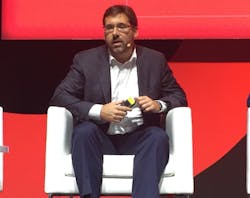One of the more practical, yet furthest reaching applications to come out of the Industrial Internet of Things (IIoT) is the digital twin—a virtualized representation of a device, system or even a factory. Of course, modeling of devices and facilities has existed for years. But the level of connectedness required by the IIoT is providing the data necessary to take modeling to new levels able to support the use of the digital twin moniker.
A session on the digital twin at the Internet of Things Solutions World Congress 2018 focused on helping users understand where the technology is today in terms of application and why industrial companies should begin serious investigations of its use.
Brad Surak, chief product and strategy officer at Hitachi Vantara (a business unit of Hitachi that combines industrial expertise and analytics), highlighted several examples of the company's use of the digital twin in real-world applications. Unlike most applications where a digital twin is created to better observe operating conditions and predict maintenance for a device, Surak’s first example was more akin to creating a digital twin of the factory itself. He explained how digital twin technology was used to train Hitachi’s PMORPH robot to help clean up the Fukushima reactor destroyed by the tsunami in 2011. Surak said the first PMORPH robot deployed in the site got stuck. “So we created a digital twin of the reactor itself to train the robot on how to navigate through the spaces and capture the needed measurements,” he said.
In a similar fashion, Hitachi Vantara also created a digital twin of a train station, using video and Lidar—a surveying method using light detection and ranging—to get a sense of how people flowed through the station. This information was interfaced with the station’s escalators and people movers to manage and optimize the flow of traffic at different times during the day.
In Hitachi’s automotive factory, digital twins are used to combine video data, Lidar and sensor data to identify anomolies in machine operation. When an anomaly is detected, the digital twin of the factory helps direct a repair crew to the machine and the digital twin of the machine aids in their diagnosis, Surak said, adding “We use the digital twin to align machines and the factory floor to guide technicians” around the site and in the course of their work.
“Just like we used to build models of a [production] line to understand its capabilities, the digital twin is just an advanced model enabled by technology to [help us] get leaner and more agile.” said Hanspeter Meindl, global head of smart manufacturing at Wipro. Ultimately, applying digital twins is all about getting feedback from the real world into the digital twin to continuously improve over time.
Though digital twins are increasingly being used to model different machines and environments in a wide variety of applications, many manufacturers may find it difficult to know the best way to get started with the technology. Mark Gallant, senior director of IoT Solutions at PTC, suggests connecting with plant managers first. “They inherently know the [facility’s] top three machines in terms of criticality to your operations. That’s where you start with your digital twin,” he said.
To highlight the level of improvement that can be achieved with a digital twin, Gallant cited PTC’s work with one customer who wanted to use the technology improve its quality by 20 percent. Within the project's timeframe, Gallant said the manufacturer was creating 1,600 out-of-spec products. They wanted to get this number into the 1,200 range. The initial application of the digital twin of the machine led to a 50 percent improvement in quality, with only 800 products being produced out of spec.
Leaders relevant to this article:


